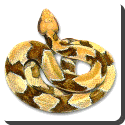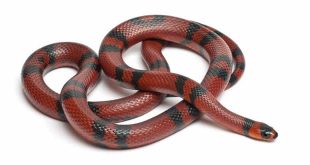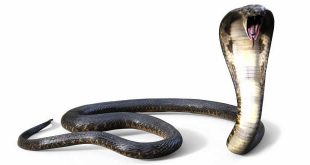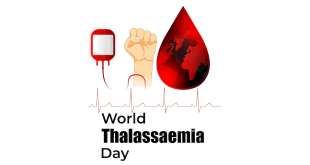 Copperhead — The Copperhead is the most common venomous snake found in the eastern US. It is also known by the name “Highland Moccasin.” As a species, it belongs to the genus “Agkistrodon” which also includes the Cottonmouth, also known as the “Water Moccasin”.
Copperhead — The Copperhead is the most common venomous snake found in the eastern US. It is also known by the name “Highland Moccasin.” As a species, it belongs to the genus “Agkistrodon” which also includes the Cottonmouth, also known as the “Water Moccasin”.
Copperheads are usually colorful and strikingly patterned snakes. They derive their name from the copper-like coloring of the head. The background color of the back and sides is tan to pinkish. There are darker, chestnut colored bands across the back and sides. Each band is of varing width, often described as hour-glass shaped. Newborn Copperheads are colored and patterned like adults, excepting the last inch of so of the tail which will be a bright, sulfur yellow color.
Adults are usually in the range of 24 to 36 inches in length, although specimens of greater than 42 inches are not rare. They give live birth to young. Copperheads eat small rodents, birds, lizards, snakes, amphibians, and insects.
Copperheads are venomous, pit vipers. Copperheads account for more cases of venomous snake bite than any of our other species. Fortunately, their venom is the least toxic of our species. Bites from Copperheads are very seldom fatal; however, a bite may still produce serious consequences.
There are 2 subspecies of Copperheads occuring in South Carolina. Both subspecies appear very similar, although the Southern is usually lighter colored. The most widespread is the Southern Copperhead which ranges from the coast to the upper Piedmont. The Northern Copperhead is found in the Mountains and upper Piedmont. It is probable that most of the specimens from the Piedmont are intergrades although my experience has been that most appear more like Southerns.
Copperheads can be found in most all habitats, although they often prefer to be near streams and other waterways. They may be found on hilltops or lowlands. It is not unusual for Copperheads to be found in forested or undeveloped areas within and near suburban developments. The Copperhead is one of the most successful of our larger snake species. It is usually not difficult to find a Copperhead crossing a road on a warm summer night. Because of their habit of freezing at the approach of danger, many are killed by vehicle traffic.
Copperheads prefer habitats with lots of vines, vegetation and/or debris. Their coloration and patterning is very effective for camouflage in dead leaves on the forest floor. Copperheads rely upon camouflage and cover for safety. When danger is perceived, Copperheads will usually freeze in place and remain motionless for the threat to pass. This strategy works well in their natural habitat. Unless a person steps on them, grasps them, or otherwise comes very, very close to them, Copperheads will not usually bite. However, the bite will be readily used as a last defence. An agitated Copperhead will vibrate its tail rapidly. The relative abundance of Copperheads and their occurrences near human habitations is the reason bites from Copperheads are at the top of venomous snake bite statistics in the eastern US.
 Kids Portal For Parents India Kids Network
Kids Portal For Parents India Kids Network


